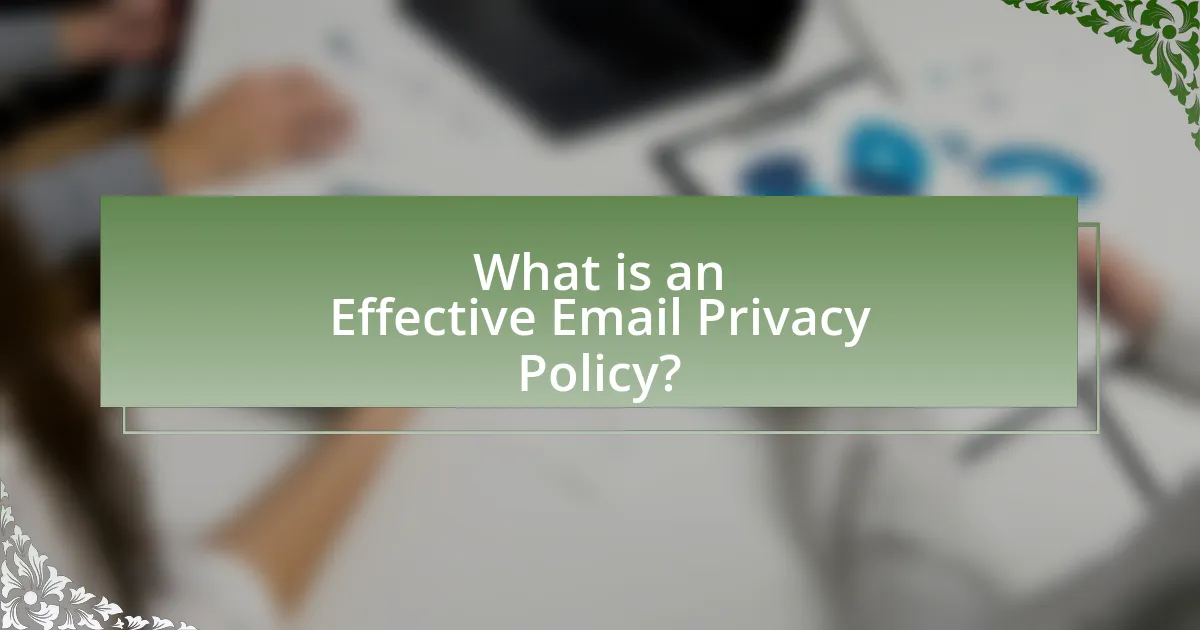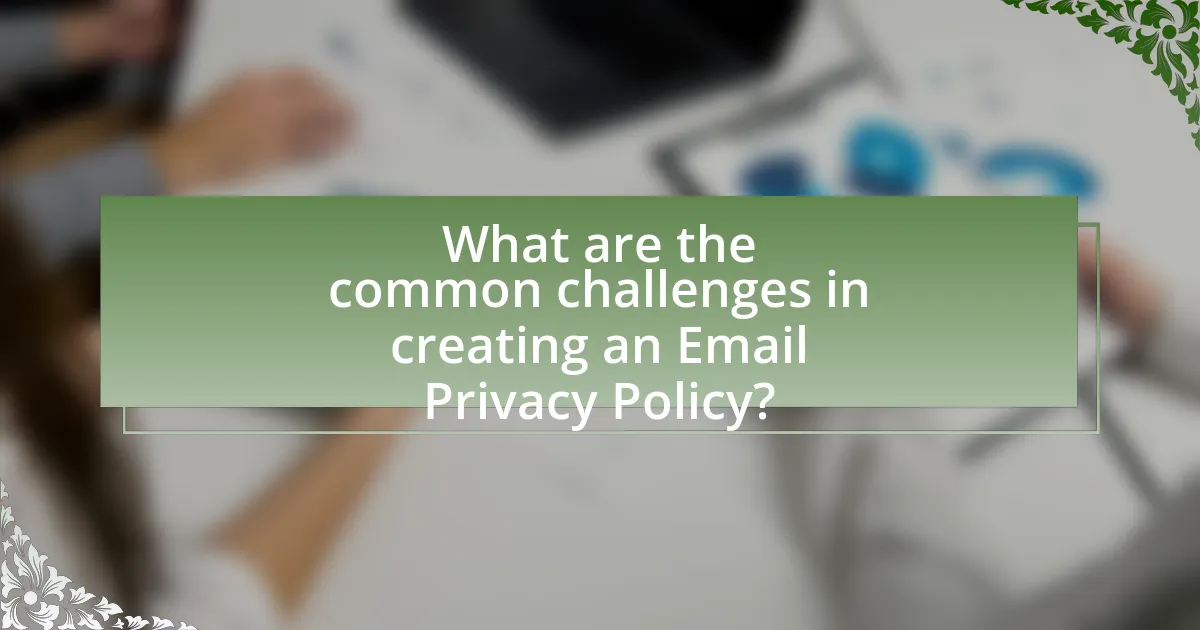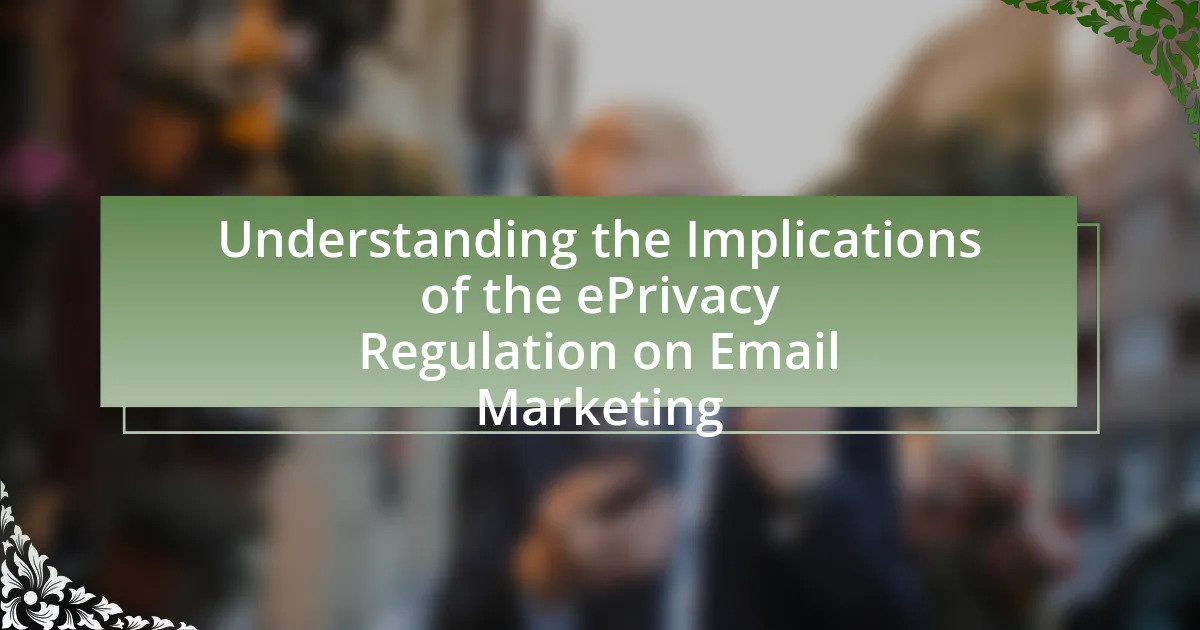An effective email privacy policy is a formal document that outlines how organizations collect, use, protect, and share personal information obtained through email communications. This article details the importance of such policies for businesses, emphasizing compliance with legal regulations like the GDPR and CCPA, and the necessity of transparency in data handling practices. Key elements of an email privacy policy include data collection practices, user rights, security measures, and consent mechanisms. The article also addresses common challenges in policy creation, misconceptions businesses may have, and best practices for ensuring clarity and accessibility, ultimately highlighting the significance of user feedback in refining these policies.

What is an Effective Email Privacy Policy?
An effective email privacy policy is a formal document that outlines how an organization collects, uses, protects, and shares personal information obtained through email communications. This policy should clearly define the types of data collected, the purpose of data collection, and the measures taken to ensure data security, such as encryption and access controls. Additionally, it must inform users of their rights regarding their personal information, including options for opting out of data collection and procedures for data access or deletion. According to the General Data Protection Regulation (GDPR), organizations must provide transparency about data processing activities, which reinforces the necessity of a comprehensive email privacy policy.
Why is an Email Privacy Policy important for businesses?
An Email Privacy Policy is important for businesses because it establishes guidelines for the collection, use, and protection of personal information shared via email. This policy helps businesses comply with legal regulations, such as the General Data Protection Regulation (GDPR) and the California Consumer Privacy Act (CCPA), which mandate transparency in data handling practices. By implementing a clear Email Privacy Policy, businesses can build trust with customers, reduce the risk of data breaches, and mitigate potential legal liabilities. According to a study by the Ponemon Institute, organizations with strong data protection policies experience 50% fewer data breaches, highlighting the effectiveness of such policies in safeguarding sensitive information.
What legal requirements must be considered in an Email Privacy Policy?
An Email Privacy Policy must consider legal requirements such as compliance with the General Data Protection Regulation (GDPR) for users in the European Union, the California Consumer Privacy Act (CCPA) for residents of California, and the CAN-SPAM Act in the United States. These regulations mandate transparency in data collection, user consent for data processing, the right to access personal data, and the option to opt-out of marketing communications. For instance, GDPR requires organizations to inform users about how their data will be used and to obtain explicit consent before processing personal information. Compliance with these laws is essential to avoid legal penalties and to protect user privacy.
How does an Email Privacy Policy protect user data?
An Email Privacy Policy protects user data by clearly outlining how personal information is collected, used, and safeguarded by the organization. This policy establishes transparency, ensuring users understand their rights regarding their data, including consent for data collection and the purpose behind it. Furthermore, it typically includes measures such as data encryption, access controls, and protocols for data breaches, which collectively enhance the security of user information. For instance, organizations that implement robust privacy policies can reduce the risk of data breaches by up to 50%, as indicated by studies on data protection practices.
What key elements should be included in an Email Privacy Policy?
An Email Privacy Policy should include key elements such as data collection practices, data usage, data sharing, user rights, security measures, and contact information. Data collection practices must specify what information is collected from users, such as email addresses and preferences. Data usage should outline how the collected information will be utilized, including purposes like marketing or service improvement. Data sharing must clarify if and with whom the information may be shared, such as third-party service providers. User rights should inform users about their rights regarding their data, including access, correction, and deletion. Security measures must detail the steps taken to protect user data from unauthorized access or breaches. Finally, contact information should provide users with a way to reach out for inquiries or concerns regarding their privacy. These elements ensure transparency and compliance with privacy regulations, fostering trust between the organization and its users.
What information should be collected from users?
User information that should be collected includes email addresses, names, and consent for data processing. Email addresses are essential for communication and service delivery, while names help personalize interactions. Consent is crucial for compliance with data protection regulations, such as the General Data Protection Regulation (GDPR), which mandates that users must agree to how their data will be used. Collecting this information ensures transparency and builds trust between the organization and its users.
How should consent be obtained from users?
Consent should be obtained from users through clear, explicit, and informed mechanisms. This involves providing users with straightforward information about what they are consenting to, including the purpose of data collection and how their information will be used. For instance, a checkbox that users must actively select, accompanied by a brief explanation of the data practices, ensures that consent is not only given but also understood. Research indicates that 88% of consumers are more likely to engage with brands that prioritize transparency in data usage, highlighting the importance of clear consent processes.
How can businesses ensure compliance with their Email Privacy Policy?
Businesses can ensure compliance with their Email Privacy Policy by implementing regular audits and training programs for employees. Regular audits help identify any gaps in adherence to the policy, while training ensures that employees understand the importance of email privacy and the specific practices required to maintain compliance. According to a study by the International Association of Privacy Professionals, organizations that conduct regular privacy training see a 30% reduction in privacy incidents. Additionally, businesses should establish clear procedures for handling personal data and ensure that all email communications are in line with the policy.
What steps should be taken to regularly review and update the policy?
To regularly review and update the email privacy policy, organizations should establish a scheduled review process, typically annually or biannually. This process involves assessing the policy against current legal requirements, technological advancements, and organizational practices. Additionally, organizations should gather feedback from stakeholders, including employees and customers, to identify areas for improvement. Monitoring industry trends and best practices is also essential to ensure the policy remains relevant and effective. Regular training sessions for staff on policy updates can further enhance compliance and awareness.
How can businesses train employees on the Email Privacy Policy?
Businesses can train employees on the Email Privacy Policy by implementing structured training programs that include workshops, online courses, and regular updates. These training sessions should cover the key components of the policy, such as data protection, acceptable use, and consequences of violations. According to a study by the Ponemon Institute, organizations that provide comprehensive training on data privacy see a 30% reduction in data breaches. Regular assessments and quizzes can reinforce understanding and retention of the policy, ensuring that employees are well-informed and compliant.

What are the common challenges in creating an Email Privacy Policy?
Common challenges in creating an Email Privacy Policy include ensuring compliance with various regulations, addressing user consent, and maintaining transparency about data usage. Compliance is complex due to differing laws like GDPR in Europe and CCPA in California, which impose strict requirements on data handling. User consent presents difficulties as organizations must clearly communicate how data will be used and obtain explicit permission, which can be challenging to manage effectively. Transparency is essential, yet many organizations struggle to articulate their data practices in a way that is easily understandable to users, leading to potential mistrust. These challenges highlight the need for careful consideration and expertise in legal and communication aspects when developing an Email Privacy Policy.
What misconceptions do businesses have about Email Privacy Policies?
Businesses often mistakenly believe that email privacy policies are solely about compliance with regulations, overlooking the importance of building customer trust. This misconception can lead to inadequate policies that fail to address user concerns about data security and privacy. For instance, a study by the International Association of Privacy Professionals found that 70% of consumers are more likely to engage with companies that demonstrate transparency in their data practices. Therefore, businesses should recognize that effective email privacy policies not only fulfill legal obligations but also enhance customer relationships by fostering trust and transparency.
How can businesses address these misconceptions effectively?
Businesses can address misconceptions about email privacy policies effectively by providing clear, transparent communication regarding their data practices. This involves outlining how personal information is collected, used, and protected in a straightforward manner. For instance, a study by the International Association of Privacy Professionals found that 70% of consumers are more likely to trust companies that clearly explain their privacy policies. By utilizing simple language and avoiding legal jargon, businesses can enhance understanding and build trust with their audience. Additionally, offering regular updates and educational resources about privacy practices can further dispel myths and reinforce the company’s commitment to protecting user data.
What are the potential consequences of not having an Email Privacy Policy?
Not having an Email Privacy Policy can lead to significant legal and reputational consequences for an organization. Without a clear policy, organizations risk violating data protection laws such as the General Data Protection Regulation (GDPR) or the California Consumer Privacy Act (CCPA), which can result in hefty fines and legal action. Additionally, the absence of a policy can erode customer trust, as individuals may feel their personal information is not adequately protected, leading to decreased engagement and potential loss of business. Furthermore, organizations may face increased vulnerability to data breaches, as a lack of guidelines can result in inconsistent handling of sensitive information.
What legal actions can be taken against businesses for non-compliance?
Legal actions that can be taken against businesses for non-compliance include fines, penalties, lawsuits, and regulatory sanctions. For instance, under the General Data Protection Regulation (GDPR), businesses can face fines of up to 4% of their annual global turnover or €20 million, whichever is higher, for failing to comply with data protection requirements. Additionally, non-compliance can lead to civil lawsuits from affected individuals or groups, resulting in further financial liabilities and reputational damage. Regulatory bodies may also impose sanctions, including the suspension of business operations or revocation of licenses, to enforce compliance with legal standards.
How can a lack of a policy damage a business’s reputation?
A lack of a policy can significantly damage a business’s reputation by leading to inconsistent practices and potential violations of customer trust. Without a clear email privacy policy, businesses may inadvertently expose sensitive customer information, resulting in data breaches that can erode consumer confidence. For instance, according to a 2020 study by IBM, the average cost of a data breach is $3.86 million, which can severely impact a company’s public image and customer loyalty. Furthermore, businesses lacking policies may face negative media coverage and legal repercussions, further tarnishing their reputation in the eyes of stakeholders and the public.

How can businesses communicate their Email Privacy Policy effectively?
Businesses can communicate their Email Privacy Policy effectively by ensuring it is clear, accessible, and prominently displayed on their website and within email communications. A well-structured policy should use straightforward language to explain how customer data is collected, used, and protected, which helps build trust. According to a study by the International Association of Privacy Professionals, 79% of consumers are more likely to engage with a company that demonstrates transparency about data practices. Additionally, businesses should provide easy-to-find links to the policy in email footers and during the sign-up process, ensuring that customers can review it before consenting to data collection.
What strategies can be used to inform users about the policy?
To inform users about the email privacy policy, organizations can utilize multiple strategies including clear communication through various channels, regular updates, and user-friendly formats. Clear communication involves sending direct emails that outline the policy’s key points, ensuring that users understand their rights and the organization’s practices. Regular updates can be communicated through newsletters or website announcements whenever there are changes to the policy, keeping users informed and engaged. Additionally, presenting the policy in user-friendly formats, such as FAQs or infographics, can enhance comprehension and accessibility. These strategies are effective as they align with best practices in user engagement and transparency, fostering trust between the organization and its users.
How can businesses make the policy easily accessible to users?
Businesses can make the policy easily accessible to users by prominently displaying it on their website and ensuring it is easy to navigate. This can be achieved by placing a direct link to the policy in the website footer, on the registration page, and within email communications. According to a study by the International Association of Privacy Professionals, 70% of users prefer clear and easily accessible privacy policies, which enhances user trust and compliance with regulations. Additionally, using plain language and summarizing key points can further improve accessibility, as evidenced by research from the Pew Research Center, which found that simplified language increases user comprehension and engagement.
What best practices should be followed when drafting an Email Privacy Policy?
When drafting an Email Privacy Policy, it is essential to clearly outline how personal data will be collected, used, and protected. This includes specifying the types of information collected, such as email addresses and user preferences, and detailing the purposes for which this information will be used, like marketing or service updates.
Additionally, the policy should inform users about their rights regarding their data, including the ability to access, modify, or delete their information. Transparency is crucial; therefore, the policy must disclose any third parties with whom data may be shared and the reasons for such sharing.
Furthermore, it is important to include information on data security measures in place to protect user information from unauthorized access or breaches. Regular updates to the policy should be communicated to users, ensuring they are aware of any changes.
Finally, compliance with relevant regulations, such as the General Data Protection Regulation (GDPR) or the California Consumer Privacy Act (CCPA), is necessary to ensure legal adherence and build user trust.
How can businesses ensure clarity and transparency in their policy?
Businesses can ensure clarity and transparency in their policy by using clear language, providing detailed explanations, and making the policy easily accessible. Clear language avoids jargon and complex terms, which can confuse readers. Detailed explanations of each section help users understand their rights and obligations. Making the policy easily accessible, such as through a dedicated webpage or during the sign-up process, ensures that users can find and review the policy at any time. According to a study by the International Association of Privacy Professionals, clear and accessible privacy policies increase user trust and compliance, demonstrating the effectiveness of these practices in fostering transparency.
What role does user feedback play in refining the Email Privacy Policy?
User feedback is crucial in refining the Email Privacy Policy as it provides insights into user concerns and expectations regarding data privacy. By analyzing feedback, organizations can identify specific areas of the policy that may be unclear or inadequate, allowing for targeted revisions that enhance transparency and user trust. For instance, a survey conducted by the Pew Research Center found that 79% of Americans are concerned about how their data is used by companies, highlighting the importance of addressing user feedback to align policies with user expectations. This iterative process ensures that the Email Privacy Policy remains relevant and effective in protecting user privacy.
What practical tips can help in creating an effective Email Privacy Policy?
To create an effective Email Privacy Policy, organizations should clearly define the types of personal data collected, how it will be used, and the measures taken to protect that data. Transparency is crucial; therefore, explicitly stating the purpose of data collection, such as for marketing or service improvement, helps build trust with users. Additionally, including information on user rights, such as the ability to access, modify, or delete their data, is essential for compliance with regulations like GDPR. Regularly updating the policy to reflect changes in data practices or legal requirements ensures ongoing relevance and effectiveness.




